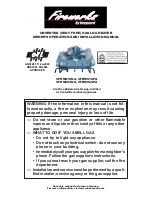
25
Heat & Glo • TIARA II-B • 7011-148 Rev. G • 10/12
Leak test all gas line joints and the gas control valve prior
to and after starting the appliance.
Before making the gas connection, ensure that the appliance
you are installing is designed for the type of gas being
supplied. This information can be found on the ratings label
under the appliance. If the appliance has been converted
to propane (LP), the valve cover should have a label stating
that the appliance has been converted to propane.
Connect the gas line at the 3/8 in. (10mm) pipe connector
on the valve at the back of appliance.
We recommend
connecting the appliance with an approved flex gas line.
If flex gas lines are not approved in your area, you must
connect a hard pipe to the gas hookup.
You must supply a manual shut-off valve in a visible location
within 3 ft. (914mm) of the appliance.
HIGH ALTITUDE INSTALLATIONS
Omni-Test Laboratories, Inc. listed gas appliances are tested and
approved without requiring changes for elevations from 0 to 2000
feet in the U.S.A. and 0 to 4500 feet in Canada.
When installing this appliance at an elevation above 2000 feet,
it may be necessary to decrease the input rating by changing
the existing burner orifi ce to a smaller size. Input rate should be
reduced by 4% for each 1000 feet above a 2000 foot elevation
in the U.S.A. If the heating value of the gas has been reduced,
these rules do not apply. To identify the proper orifi ce size, check
with the local gas utility.
If installing this appliance at an elevation above 4500 feet (in
Canada), check with local authorities.
A small amount of air will be in the gas supply lines. When
fi rst lighting appliance it will take a short time for air to
purge from lines. When purging is complete the appliance
will light and operate normally.
Air only needs to be purged again if gas valve has been
turned to the OFF position.
WARNING
Fire Risk.
Do NOT change the valve settings.
• This valve has been preset at the factory.
• Changing valve settings may result in fi re
hazard or bodily injury.
WARNING
Fire Risk or Explosion Hazard.
• Gas build-up during line purge may ignite.
• Purge should be performed by a qualifi ed
technician.
• Ensure adequate ventilation.
• Ensure there are no ignition sources such
as sparks or open fl ame.
WARNING
CHECK FOR GAS LEAKS
Explosion Risk.
Fire Risk.
Asphyxiation Risk.
• Check
the
fi ttings and connections
• Do not use open fl ame.
• After the gas line installation is complete, all
connections must be tightened and checked
for leaks with a commercially-available, non-
corrosive leak check solution. Be sure to rinse
off all leak check solution following testing.
Fittings and connections may have loosened during
shipping and handling.
C. Gas Connection (Cont’d)
















































